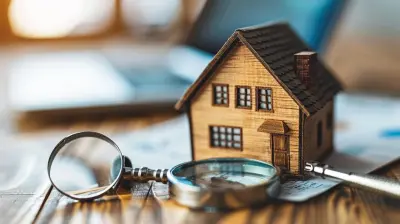What to Expect During a Buyer’s Home Inspection for FSBO
17 November 2025
So, you're selling your house without a real estate agent—go you! For Sale By Owner (FSBO) can be a rewarding way to save on commission fees and maintain full control over your sale, but it's not always smooth sailing. One of the biggest moments in the process? The buyer’s home inspection.
Whether you’re just starting the FSBO journey or preparing for an offer, knowing what happens during the home inspection can help you stay ahead of the game. After all, nobody wants a deal to fall apart because of a leaky water heater or a surprise structural issue.
In this guide, we’re going to walk you through exactly what to expect during a buyer’s home inspection for FSBO—from what inspectors actually look for, how to prep your home, common deal-breakers, and how to respond if repairs are requested. Ready? Let’s get into it.
What Is a Home Inspection, Anyway?
Let’s start from square one. A home inspection is a thorough, top-to-bottom review of your property by a licensed home inspector, usually hired and paid for by the buyer. The goal? Make sure the house they’re buying isn’t hiding any nasty surprises.Think of it like a physical for your house. The inspector will look at the bones (foundation, framing), organs (plumbing, electrical), and skin (roof, walls, windows) of your home. They’ll peek into crawl spaces, test outlets, and may even climb into the attic.
This is where buyers get the lowdown on the true condition of your house. It helps them decide whether to move forward, renegotiate, or walk away.
When Does the Home Inspection Happen?
Typically, the home inspection happens shortly after the buyer's offer is accepted—but before final closing. In most real estate deals, inspections are part of a contingency clause. That means the buyer can back out or ask for repairs if the results aren't up to snuff.When you’re selling FSBO, the timing might vary slightly—especially if you're handling all the negotiations yourself. But in general, the inspection is scheduled within 5-10 days post-acceptance of the offer.
What Does the Inspector Look For?
Here’s where the magnifying glass comes out. Home inspectors are trained to check every nook, cranny, and corner for issues. Here's a breakdown of what they’ll be eyeing:1. Exterior and Structure
- Foundation cracks or movement- Roof condition (missing shingles, leaks, age)
- Drainage, grading, and water flow
- Siding, stucco, paint
- Driveways, decks, railings
2. Interior Systems
- Electrical (wiring, panels, outlets)- Plumbing (pipes, water heater, fixtures)
- HVAC (heating, air conditioning, ductwork)
- Insulation and ventilation
- Smoke detectors and carbon monoxide alarms
3. Appliances and Fixtures
- Dishwasher, oven, range, garbage disposal- Toilets, sinks, showers
- Lights, fans, garbage disposals
4. Creepy Crawly Places
- Attic (insulation, ventilation, pests)- Basement and crawlspace
- Signs of mold, mildew, or pests
The inspector will take notes, photos, and possibly videos. The end result is a detailed inspection report, usually delivered to the buyer within 24-48 hours after the inspection.
As the Seller, Should You Be Present?
Short answer—nope. It’s better to give the buyer (and their inspector) space to do their job without you hovering.Buyers want to feel comfortable asking questions, and your presence could make things awkward. Plus, you have no legal right to attend unless it's agreed upon in advance. If you're dying to be in the loop, just ask your buyer or their agent for a copy of the report later.
How to Prepare Your Home for the Inspection
Don’t just cross your fingers and hope for the best. You can (and should) prep your home before the inspector shows up. Not only does this help everything go smoothly, but it also gives off the vibe that your home is well-maintained.✅ Make Sure Everything Is Accessible
Inspectors will need to get into:- Attics
- Basements and crawl spaces
- Electrical panels
- Water heaters and HVAC units
Clear the way! Move boxes, furniture, or anything blocking access.
✅ Replace Burnt-Out Bulbs
Sounds small, but a dead bulb could be flagged as a faulty fixture. Fix it now, avoid the headache later.✅ Patch Up Minor Repairs
Leaky faucet? Loose doorknob? Squeaky hinge? Knock out those small fixes before the inspection.✅ Clean the House
Yes, really. A clean home gives the impression of being cared for. It’s like brushing your teeth before the dentist—makes the whole experience smoother for everyone.✅ Offer Documentation
Leave out receipts or manuals for recent repairs or upgrades. Got a new roof or HVAC system? Show ‘em. Transparency builds trust.Common Issues That Raise Red Flags
Let’s be honest—no home is perfect. Even newer homes usually turn up something in the inspection. But here’s a list of common issues that tend to scare buyers (or at least cause them to ask for repairs or credits):- Roof damage or leaks
- Plumbing issues (especially old galvanized pipes)
- Outdated electrical systems (like knob-and-tube wiring or an overloaded panel)
- Foundation cracks or sloping floors
- HVAC systems near the end of their lifespan
- Poor drainage or mold/mildew in the basement
- Pest infestations (termites, mice, etc.)
- Water damage or rot around windows and doors
If any of these are present in your home, be ready for the buyer to negotiate post-inspection.
What Happens After the Inspection?
Here’s where the rubber meets the road. Once the buyer has the inspection report, a few things can happen:1. They Accept As-Is
Best case scenario—they read the report, feel satisfied, and move ahead toward closing.2. They Request Repairs
Buyers might ask you to fix certain issues before closing. If they're minor, you might just knock them out yourself or hire a professional. Make sure to provide receipts if you do.3. They Ask for a Price Reduction or Credit
Instead of you fixing things, buyers might want a credit at closing so they can tackle the repairs themselves.4. They Walk Away
Worst-case scenario, if the house has major problems—or the buyer gets cold feet—they might back out altogether. In FSBO deals, this can hurt more because you might have to start marketing all over again.How to Respond Like a Pro
Don’t take inspection results personally. It’s a clinical process, not a critique of your housekeeping. So how should you respond?- Stay calm and open-minded: Negotiations are normal.
- Review the report carefully: Look for legitimate problems vs nitpicks.
- Get quotes for big-ticket repairs: Sometimes the buyer's estimate is inflated.
- Be willing to compromise: Maybe you fix the roof, but not the HVAC. It’s a dance.
When you're selling FSBO, everything comes down to communication and negotiation. If you're not comfortable with that, it might be worth bringing a real estate attorney into the loop, at least for this stage.
Should You Get a Pre-Listing Inspection?
Here’s a thought: Why wait for the buyer to find problems?Getting a pre-listing inspection before you even put your home on the market can give you a huge advantage. You’ll know exactly what needs fixing, how to price your property, and avoid nasty surprises later.
Plus, it shows buyers you’ve got nothing to hide. Total transparency builds trust and can speed up the deal.
Bottom Line
Selling FSBO means you’re wearing all the hats—and the home inspection is one of the biggest hurdles you'll face. While it can be nerve-wracking, it doesn’t have to be a deal-breaker.When you know what to expect during a buyer’s home inspection for FSBO, you’re better equipped to prepare, negotiate, and close with confidence. The key is to stay proactive, transparent, and flexible. Buyers want a safe, solid home—show them you’ve got nothing to hide, and they’ll be more likely to hand over that check.
Ready to put your best foot forward? Prep that house, smile big, and ace the inspection like a champ.
all images in this post were generated using AI tools
Category:
For Sale By OwnerAuthor:

Cynthia Wilkins

